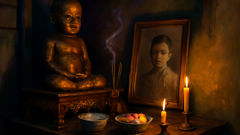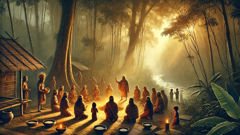Introduction
On the fringe of the rice paddies, where the earthen path narrows to a footbridge and the boundary between cultivated land and dark bamboo thicket thins, villagers still speak of the Phi Pop in low voices. It is not a story for market days or weddings; it arrives at night, when lantern-light trembles and dogs fall silent, when the air tastes faintly of fermenting fruit and distant diesel. The Phi Pop is named with a word as short and sharp as a blade, but the image it conjures stretches long: an invisible hunger that inhabits a person and, over days or months, consumes what makes them whole. People say the afflicted grow thin not only in body but in the way they smell—like old incense and wet earth—and that they dream of their insides being taken away, thread by invisible thread. In villages across Isan and the north, where Theravada Buddhism and animist practices overlap, the Phi Pop has a place in the ledger of misfortune alongside fever, livestock loss, and bad harvests. He moves between the world of the seen and the unseen, taking advantage of loosened boundaries—broken taboos, a house left unblessed, a villager who forgot to bring offerings to the spirits. There is an economy to these tales: they caution, comfort, and provide a script. They tell people how to recognize the slow, internal unraveling, who to call when a neighbor grows hollow-eyed, and what measures—both ritual and mundane—might staunch the silent eating. Under the rubber trees and beneath the eaves of wooden homes, elders articulate the signs in precise, ritual vocabulary; medics and migrant children translate these signs into fever charts and psychological diagnoses. The Phi Pop lives in that seam between explanation and fear, in the hands of the village healer and the whispered prayers at the temple steps. This story follows that seam, listening to how a community names a kind of devouring and how they try to fight it back.
Origins and the Shape of Fear
Across northeastern Thailand—Isan—the phrase phi pop arrives in conversations with the same rhythm as breathing. It is a name that holds both hostility and a strange tenderness; naming a misfortune allows people to hold it, talk to it, bargain for it. Folklorists and elder storytellers trace the idea of Phi Pop to intersections of animist practice and village anxieties about scarcity, migration, and unseen threats. In some tellings, the Phi Pop is a solitary predator, an itinerant spirit driven by pure hunger. In others, it is more complicated: a spirit offended by transgressions, a waist-thin remnant of a life cut short, or a punishment sent from offended ancestral guardians. Common to all these threads is a central horror that feels intimate rather than spectacular: the spirit possesses a human host and consumes from the inside—siphoning energy, appetite, and the warmth of organs, leaving the surface intact while the interior rots away. The fear is not only of death but of being erased from the social fabric: an afflicted person becomes unreliable in labor, in marriage, in memory. They may neglect offerings to household spirits, forget paddy seasons, fail to maintain the lines of reciprocity that keep villages cohesive.

Local healers describe the Phi Pop’s work in everyday terms. A woman who once stitched silk for temple dancers may find the thread of her patience severed; a man who was steady with a plow may drop tasks halfway and stare at nothing. Weight loss accompanies fatigue, but it is the other signals—pale lips, nightmares of being eaten, the sudden decrease in the number of insects swarm around the afflicted body—that make villagers suspect a spirit rather than a medical ailment. Midwives and older women, who have long been the repositories of local diagnosis, use observation: if a person refuses salt and rice, if their children wake from sleep screaming of hands reaching into bellies, these are signs. They look for the small anomalies, the odd smell like stale incense or the faint sound of chewing in the stillness at night—and names like Phi Pop gather around these oddities like moths.
Scholars who study Southeast Asian belief systems point out that phi, the Thai word for spirit, covers a bewildering variety: guardian deities, mischievous household shades, malevolent entities blamed for illness. Pop, as found in dialects, evokes a suddenness—a popping out, an intrusion. When combined, the term creates an image of spirit-as-intruder, a parasite in the moral and physical body of the village. The idea of internal consumption sits uneasily in modern biomedical frameworks: while doctors may diagnose consumption as disease—tuberculosis, liver failure, metabolic collapse—the community often demands a different register of action. The shaman or mor phi intercedes with herbs, chants, and strategic social rituals: the afflicted is bathed, offerings are placed at boundary markers, and sometimes the house is ritually cleansed by scattering coarse salt at thresholds. The rituals are practical as well as symbolic. They restore the person to their social role by reasserting reciprocal relationships with local spirits—offered food, returned prayers, repeated depositions of incense to ancestors. This reweaving of obligations is a social therapy, as important as any herbal remedy.
Oral histories record countless case studies where community action altered outcomes. A family would invite a spirit-medium when a young mother suddenly ceased to wake at dawn to fetch water, when she lost interest in caring for an infant and began to decline despite no obvious fever. The medium, oftentimes a woman with a long lineage of spirit-work, would sit cross-legged before the household shrine, scatter crushed betel leaves, and call aloud the names of ancestors. The performance matters: a precise sequence of words and motions must be followed so that the spirit recognizes boundaries. Sometimes the medium would negotiate: the spirit might be offered a rooster and a bowl of sticky rice and, in exchange, would be coaxed to leave the host. In other accounts, the medium would identify transgressions—an abandoned shrine, an insulted neighbor—and prescribe social repair: an apology at the wronged household, a restitution of food to the community spirit. The Phi Pop, the villagers say, is as much a creature of relationships as of hunger, an entity that responds to the ledger of offenses and offerings.
There are stories of the Phi Pop seeking out the lonely. Migrant workers who return from Bangkok with unspoken debts, adolescents who drift through the night with interrupted rites of passage—vulnerability seems to attract the spirit. This reading of myth as social allegory is not merely post-hoc rationalization; it serves a preventative function. Parents teach children to keep the household fires stable, to observe the proper sequence of offerings, to avoid tabooed foods and late-night trips into the forest. These practices reduce risk in measurable ways: they keep social ties strong, discourage nocturnal wandering where accidents happen, and maintain community oversight. In this sense, the Phi Pop is a cultural mechanism that channels anxiety about the unknown into practices that sustain mutual dependence. The mythology of interior consumption—one’s vitality stolen by a spirit—also offers an explanation for conditions that modern medicine might only partially address. It reframes wasting and mysterious decline in terms the community can act on together.
However, the stories also contain real, visceral dread. An elder recalled a farmer who in the span of a month shed both weight and voice, until he moved like a shell, unable to participate in community feasts. That death was not spectacular; there was no dramatic exorcism filmed by neighbors. Instead, there were funerary rites performed in an unusual order, a string of offerings placed to appease the hunger, and later, quiet talk that they had seen the Phi Pop leave the body like smoke. In other retellings, the afflicted are saved—through a risky, performed bargain in which the community offers a portion of its harvest to the spirit, a trade that secures the person’s recovery but leaves the village poorer. Such bargains show the moral calculus at work: the community decides if one should be saved at a collective cost. The Phi Pop myth thus loops back into the web of reciprocity that anchors communal life.
Modernity complicates all of this. Clinics and hospitals increasingly handle cases that were once described as spiritual affliction. Physicians sometimes encounter patients whose symptoms—severe weight loss, chronic fatigue, unexplained pain—do not fit neat diagnostic boxes. The coexistence of medical and ritual responses creates hybrid care: a clinic prescribes iron supplements while a medium arranges a cleansing, and the afflicted person’s recovery narrative may incorporate both interventions. For younger generations who migrate to cities and return with new vocabularies and lonelier hearts, the Phi Pop is both less believable and more urgent. It remains a versatile symbol: a cautionary tale about disconnection, a diagnosis for certain kinds of decline, and a persistent cultural memory of how communities once—and still sometimes—guarded themselves against an invisible, interior devourer.
Possession, Resistance, and Modern Meaning
To enter the literature of possession in Thailand is to learn that there is a vast, pragmatic lexicon for the interpersonal aspects of affliction. When someone is suspected of being taken by Phi Pop, the terms used are precise and numerous: the family may say that the soul has been 'loosed' (lom), that the person's 'rice bowl' is empty (translated as a loss of appetite and livelihood), or that the household guardian spirits are 'angry'—meaning the social relationship with unseen beings has been damaged. These phrases carry actionable prescriptions. The household might rearrange the altar, call a specific medium (mor phi) known for work with possession, or host a communal feast to restore balance. Each action is calibrated to be visible; since the spirit preys on the invisible, the village responds by making repair very visible—gatherings, songs, food offerings, and careful observation.

A recorded account from a northern village holds the texture of the lived experience. The afflicted person, a primary school teacher named Dao, began with headaches and a sudden inability to wake early. At first her colleagues suspected anemia; the clinic offered supplements and advised rest. But Dao’s nights worsened—she described dreams of having her insides pulled into a dark throat, and her neighbors noticed she would sometimes stand at the gate at odd hours, staring at the road as if listening. When a medium was called, the diagnosis was quick: Phi Pop. The community arranged a ritual involving roasted chicken, sticky rice, and a small sacrifice to the local guardian spirit. The medium performed a chant that connected Dao’s kin to a lineage of ancestors, naming each by relationship and thereby re-binding Dao’s social ties. This reattachment was crucial in the medium's cosmology: the Phi Pop feeds on host bodies that lack anchorage—people whose familial and social ties are frayed. After a week of ritual work and careful feeding, Dao returned to class, though she retained a quieter manner. Her story shows how ritual does something practical—reaffirm social support structures that can enable practical care, such as neighbors taking turns to prepare meals and ensure follow-up medical appointments.
Resistance to Phi Pop is not only ritual but also technological and bureaucratic. Health campaigns targeted at rural populations—vaccination drives, clinics offering tuberculosis screening, and community mental health programs—reduce the incidence of conditions that might otherwise be interpreted as spiritual affliction. Nevertheless, these programs exist in parallel to—and sometimes in conversation with—traditional ritual. A nurse who worked in rural outreach described patients who would bring ritual offerings to the clinic and ask the nurse to observe the cleansing after a medical check-up. The hybridization is pragmatic: people accept antibiotics and also expect the spirit to be spoken to and negotiated with. This pragmatic pluralism complicates simple binaries of superstition versus science. In a contested interpretive landscape, the person in decline benefits from multiple sites of intervention.
The Phi Pop myth also intersects with gender and power. Many of the most persistent stories involve women—young mothers whose social vulnerabilities multiply through childrearing pressures and economic precarity. Midwives, who are often older women with deep knowledge of herbs and rituals, occupy a liminal authority in these narratives. They must negotiate between family elders, male heads of household who control finances, and modern health providers. When a woman is afflicted, familial politics influence whether ceremonial gifts are made and whether the right medium is consulted. The outcome can hinge on choices made by those who control access to the resources necessary for rituals. This shows how belief systems about spirit-possession can mirror—and sometimes reveal—real structural vulnerabilities.
Despite its troubling core, the Phi Pop narrative can enact surprising forms of collective empowerment. In one coastal village, several neighbors were afflicted in a year of poor fishing. Instead of ostracizing the afflicted, the community organized a set of shared rituals and mutual labor events, pooling resources to feed the indigent and restore the communal shrine. These actions reduced isolation; villagers who might otherwise be blamed for misfortune were brought back into the weave of reciprocity. Ritual action, in this sense, functions as an emergency social welfare system: an accessible way to redistribute resources and attention when formal safety nets are absent. The spirit becomes, perversely, a spur to communal generosity.
Modern retellings of Phi Pop with new media complicate its presence. On social platforms, amateur videos and regional podcasts recount personal encounters with malevolent spirits. Some creators dramatize possession stories, monetizing fright; others interview elders to preserve oral histories. This new circulation changes the gravity of local stories—what was once tightly held in a village parable enters a globalized archive, where urban skeptics may mock and diasporic listeners may comfort. Yet even in virtual formats, the core lesson of Phi Pop persists: an internalized, relational model of illness that demands social reparation. Anthropology and psychiatry scholars have taken interest in how narratives of the Phi Pop map to conditions such as chronic fatigue, eating disorders, and certain dissociative phenomena. It is tempting to read the myth solely through biomedical eyes, but such reduction misses the moral reasoning encoded in ritual responses. The myth does more than name a condition; it prescribes channels of blame, reconciliation, and mutual aid.
Perhaps the most unsettling stories are those in which exorcism fails. A family may stage a dramatic cleansing—fire, chanting, and the slaughter of a rooster—yet the afflicted remains altered, withdrawn, and fragile. To villagers, such a failure can signal a deeper wound in the community: unresolved disputes, the abandonment of local guardianship, or the erosion of customary practice. In these narratives, the Phi Pop is a messenger: a symptom of communal decay. Thus, the spirit’s presence becomes a call to action, reminding communities that social infrastructure—shared meals, attentive kin, rituals at the right times—matters. In an era when migration, economic shifts, and changing belief patterns stretch the fabric of rural life, the Phi Pop is an old voice insisting on the maintenance of social ties that keep both illness and alienation at bay.
Conclusion
The Phi Pop legend endures because it speaks to universal anxieties in a form that is both intimate and communal. It frames slow decline as an attack on relational stability and offers a repertoire of actions that can be taken by families and neighbors alike. Whether treated as superstition, metaphor, or a real presence, the Phi Pop is a cultural work: a way for communities to name vulnerabilities, to mobilize care, and to enact repair. In the modern world, the myth adapts—hybridized with medical practice, migrating into podcasts, changing shape as young people move to cities and elders hold tighter to old rituals. But its core remains: the warning that hunger can be interior and social at once, and that healing is most often performed in public—through meals shared, apologies given, shrines maintained, and stories told under lantern light. Those who hear the stories are invited to act, not merely to fear. They are asked to keep the thresholds tidy, to speak the names of ancestors aloud, to notice the small changes in a neighbor’s step, and to respond with a mixture of ritual, food, and practical care. In that blend of compassion and ceremony, the Phi Pop—whether spirit, metaphor, or symptom—loses some of its power. The act of collective tending, after all, is the oldest and most durable defense the village has.













